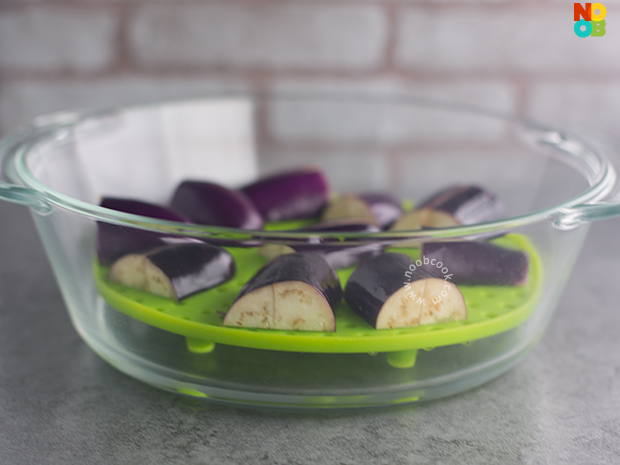How to retain the beautiful purple of eggplants after cooking

Have you ever made a dish where the eggplant (brinjal or aubergine) turns an unflattering brown after cooking? While the taste is not affected, the brown eggplants don’t look too good in terms of presentation. This is a tutorial for retaining an eggplant’s gorgeous purple after cooking.
See Also:
The science behind retaining the purple hue is to cook and ‘lock-in’ the eggplant colour at a high temperature (above 100°C ). The most common method used by restaurants is to deep-fry the eggplants, which to me is too cumbersome and oily. The three methods (boil, microwave or steam) outlined in this tutorial are healthier and hassle-free. The boiled/steamed/microwaved eggplants, not soaked in oil, will also be better at absorbing any sauce or seasonings they are cooked in.

Whichever method you use, choose eggplants of a dark purple shade (as above) as they may turn a shade lighter after cooking. Cut them to uniform sections or “logs”. Precision is key, so always make sure the temperature of the water is above 100°C (water must be rapidly not slow boiling) and use a kitchen timer to keep time.
METHOD 1: BOILING

Bring a pot of water to a rapid boil. Add cut eggplant into the boiling water. To ensure that the eggplants are submerged in the water throughout the entire cooking duration, weigh them down with something heavier such as a drop lid or a slotted ladle as pictured above (note that the eggplants are under the ladle). Any purple skin not submerged in the boiling water (exposed to air) during the boiling process will turn brown. Boil for 3 minutes.

These are the drained eggplants after cooking. The purple colour is really radiant and consistent here. If this is your first time using this method, you will need to tweak to get with your perfect set up using whatever kitchen tools you can use in your kitchen, to ensure that the eggplants can be fully submerged in the boiling water during cooking.

I used the boiled eggplants in a simple chilli bean paste eggplants stir-fry.
METHOD 2: MICROWAVE

The microwave method is super easy if you have the right equipment. Most importantly, your microwave oven must have the setting for 1000 watts and above. The results are not good below 1000 watts. You also need a microwave-safe casserole with a lid. The set up pictured above consists of a silicone steamer insert tray inside a microwave-safe glass casserole. It came with my microwave oven. Add a few tablespoon water at the bottom of the casserole. Arrange cut eggplants, skin-side up, on the slotted insert tray (the green thing).

Brush the purple skin of the eggplants with olive oil.

Cover the microwave-safe casserole with lid and microwave at 1000W for 3 minutes.

These are my eggplants after microwaving. Although there are some brown spots, the purple is very vibrant. The microwaved eggplant result is like a combination of steaming and deep-frying. Caution: Be careful of hot latent steam escaping the casserole when you open the lid. Always wear oven gloves when handling the hot casserole.

If you don’t have the steamer insert tray, fret not. Just place cut eggplants skin side up on a microwave-safe casserole, brush the skin with olive oil and drizzle 1-2 tablespoons of water around the eggplants.

I made this claypot eggplant with basil using the microwaved eggplants.
METHOD 3: STEAMING

Bring water in the steamer (I’m using a large Chinese wok here) to a rapid boil.

Add steamer basket (I got this from Ikea) of cut eggplants into the wok. Cover the wok with a lid and steam for 4 minutes.

This is my steamed eggplants after 4 minutes. They are very tender and retain most of its purple hue with only a few small spots of browning.

The steamed eggplants are used in my black bean sauce eggplants.

All three methods (boil, microwave, steam) are great alternatives to the traditional method of deep frying. When cooked in the above ways, the eggplant purple hue is mostly ‘locked-in’ and retained when you add them to your dishes and stir-fries later. My favourite method at the moment is the microwave, because I can free up my precious stove area. With this tutorial, even a noob cook can now serve eggplants like a pro with its beautiful purple shining through on the dinner table.












I miss those eggplants. Have never seen them over here..I like the boiling method.
Thanks Wiffy for your time and efforts in going through all these methods. Really appreciate.
It’s my pleasure, and I hope they will come in useful for you. Let me know how it goes :)
May I know how to prevent it from browning after cut?
It wouldn’t really turn brown if cut when raw? Sorry I don’t really understand your question.
Do you need to submerge in cold water after taking it out from the boiling water? To stop the cooking of the eggplant with the heat?
It helps a little bit for boiling & steaming methods. I personally find that that there is not much difference (the most important factor is still to cook the purplish part at a high heat), so I don’t do that step.
I prepared eggplant as usual for eggplant parm, but after cooking they turned a bright green. Taste was not altered and I sampled before serving so they did not make me sick.. The obey thing that was different about these eggplant was that they were Organic.
Any explanation?
I’d like to leave the eggplant whole as I’d still need to cut and sit sprinkled in salt. Before browning the eggplant in oil. Have you blanched the whole eggplant?